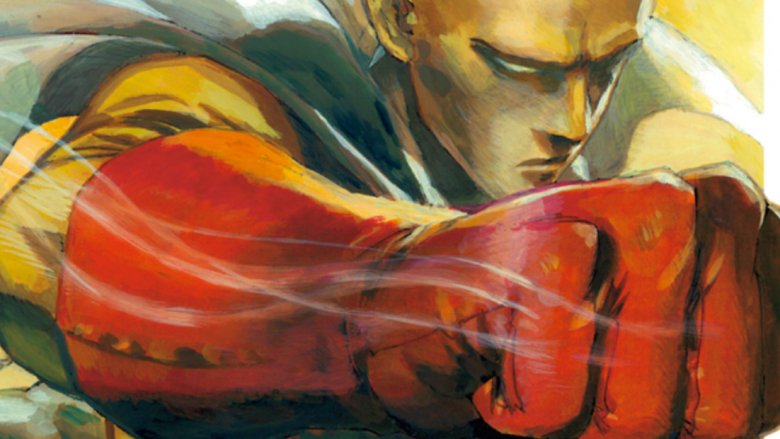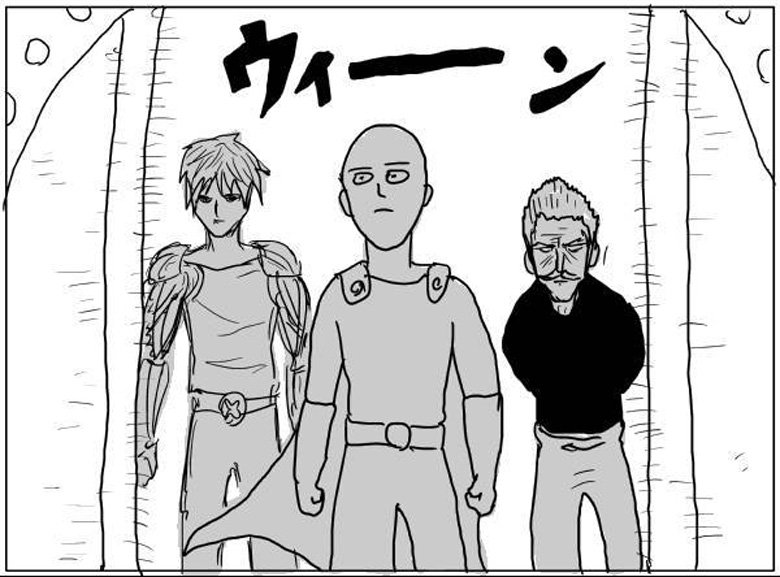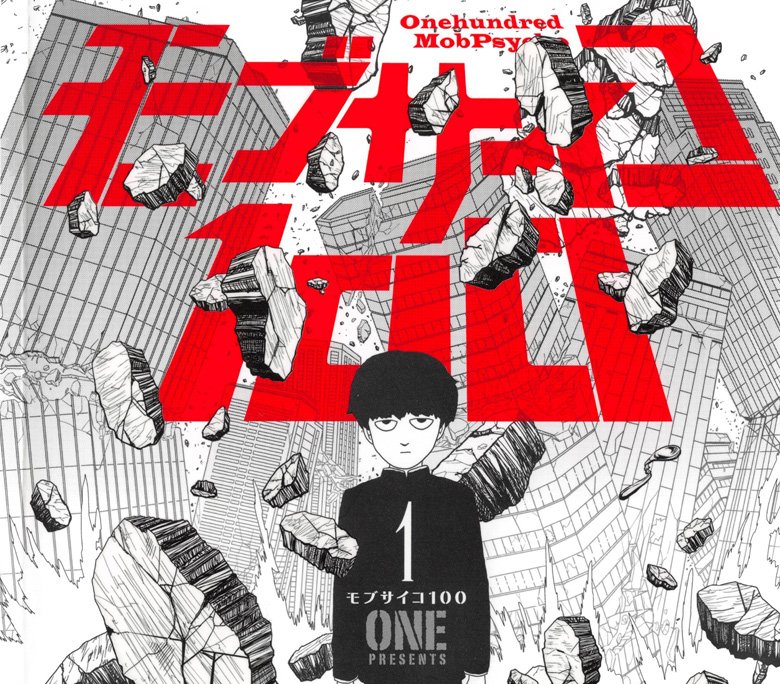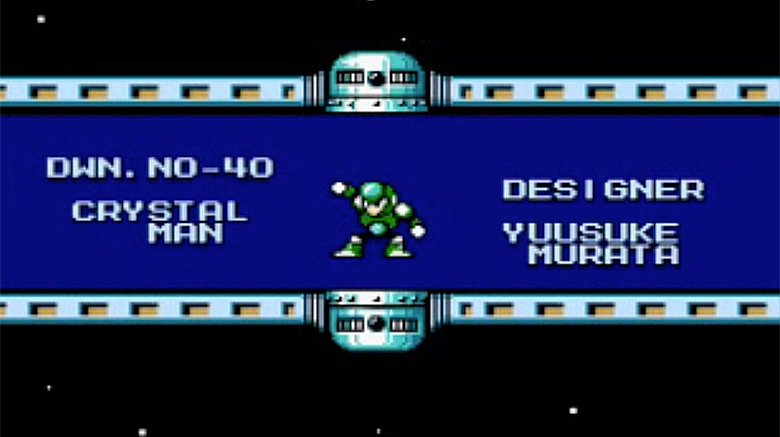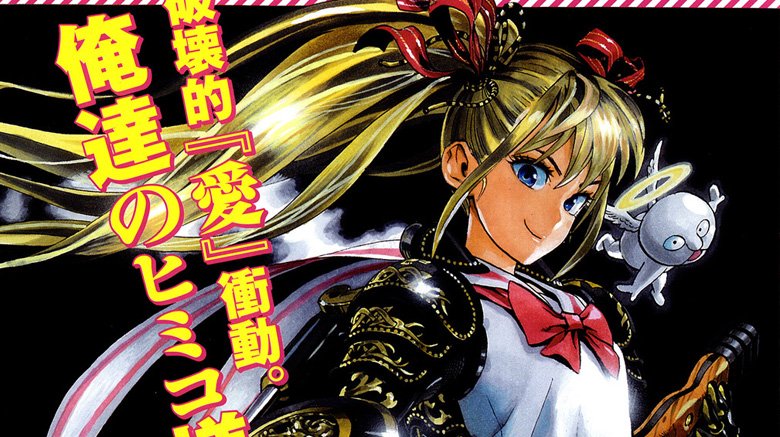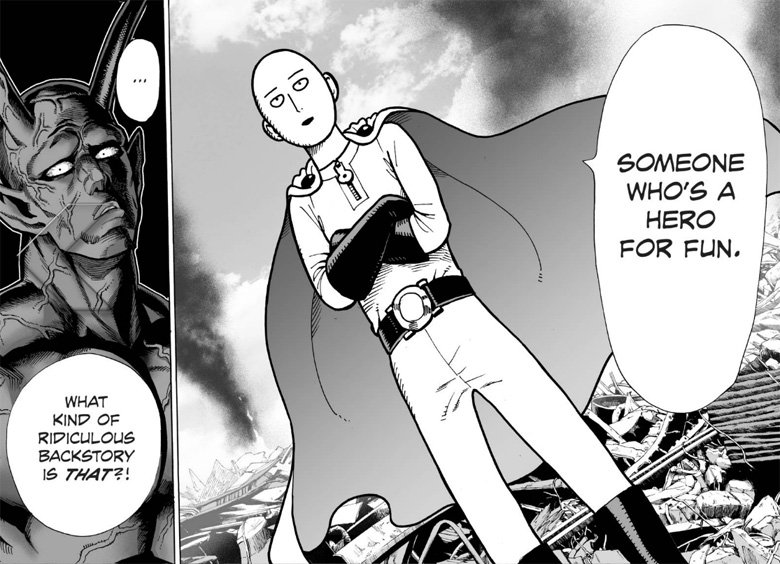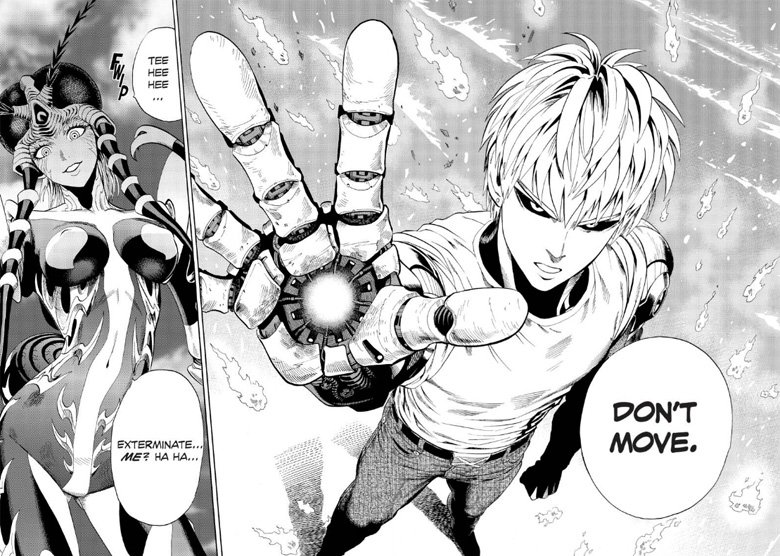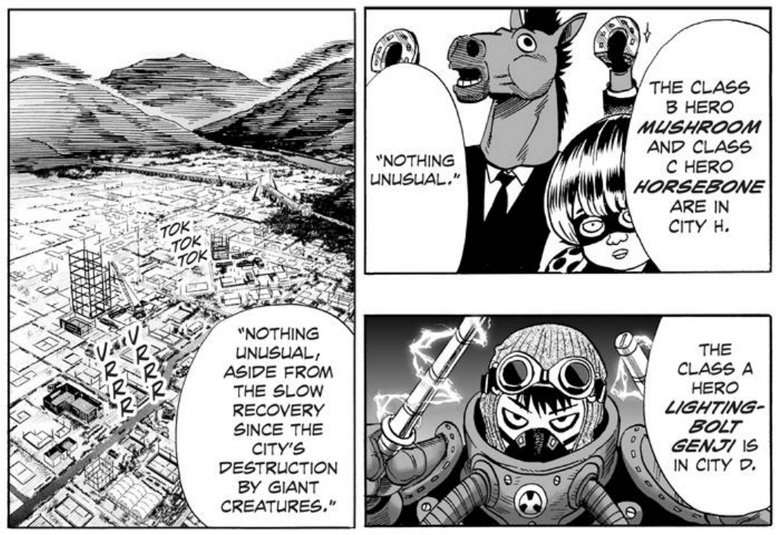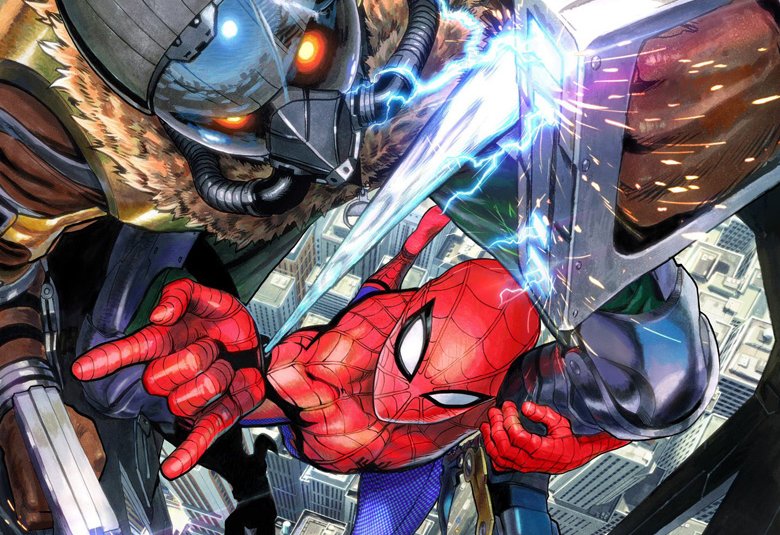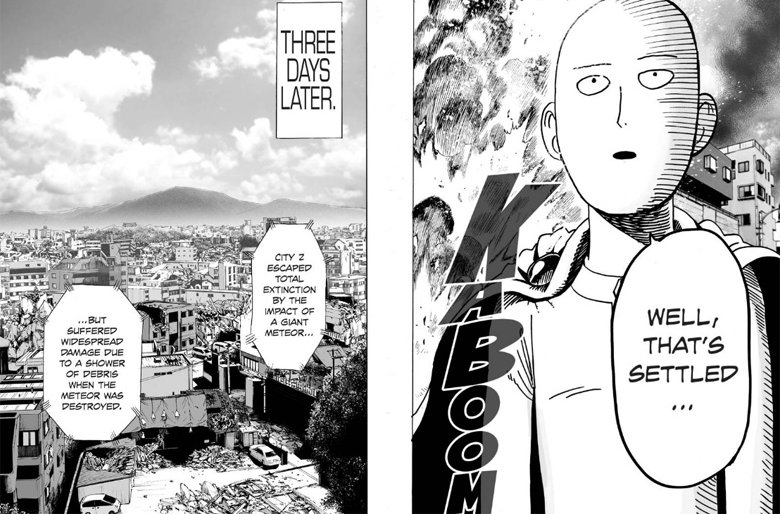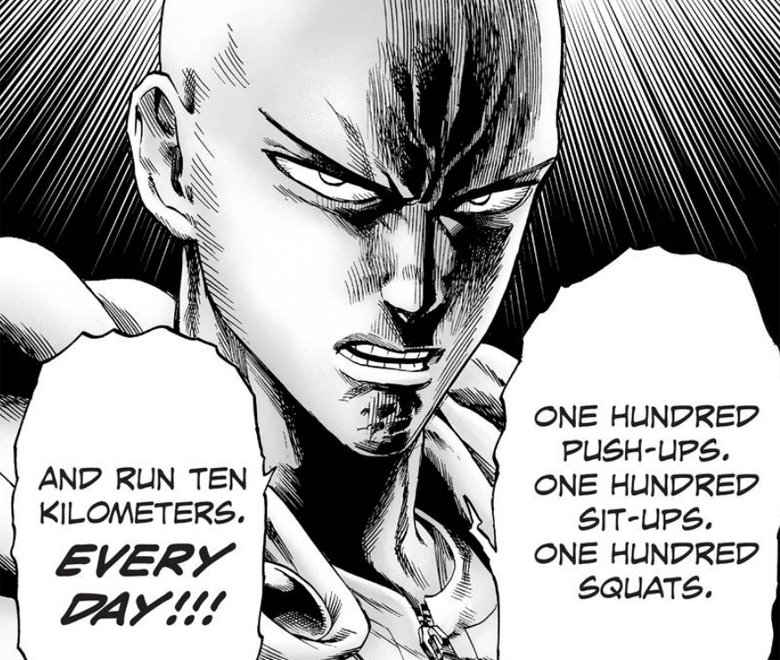The Untold Truth Of One-Punch Man
The most powerful superhero in comics today isn't Superman or Captain America. It's Saitama, the bald, unassuming, and ridiculously deadly title character of ONE and Yusuke Murata's One Punch Man. Set in a world that's constantly under attack by giant monsters, it tells the story of a guy who decided to be a hero for fun, and wound up becoming so strong that he could defeat any opponent with a single punch.
And like all great superheroes, Saitama has a secret origin. It winds its way through hidden notebooks, video game contests, late-night webcomic binges and exhausting animation, so read on, and find out who One Punch Man is, and how he came to be!
It started as a webcomic
Long before it was an international bestseller with over 11 million copies in print, One Punch Man was a webcomic launched in 2009 by ONE, a lifelong manga fan who once told an interviewer that one of the big advantages of working online was that "you can draw a webcomic even if you're not that great, challenge yourself, and if it doesn't work out you're free to quit anytime at your own discretion."
Needless to say, it did work out. On a site where a comic was considered a "success" if it got 30 viewers, One Punch Man drew thousands within a few weeks of starting, attracting the attention of people like Akiman, the legendary artist responsible for the character designs in video games like Street Fighter II, Darkstalkers, and Final Fight. By 2012, Akiman had recommended the webcomic to artist Yusuke Murata, who teamed up with ONE for a remake of the webcomic that would run in the pages of Weekly Shonen Jump, expanding on the world and characters that ONE had created online.
If you're familiar with that version, then going back to the webcomic makes for an interesting experience. As you might expect from his claims of being "not that great," ONE's art is a completely different style from Murata's detailed, highly polished work, but the character designs, ideas, and sense of humor that make One Punch Man a hit are already there. You can still check out the whole thing online—assuming, of course, that you can read Japanese.
The secret origin of ONE
While One Punch Man might've seemed like an instant success, ONE had actually been drawing comics for years before his breakout hit. The only problem? No one ever saw them.
In the same interview linked above, ONE revealed that he spent his school years filling "about 50 notebooks" with pages of wild ideas, including a superhero called Middle-Aged-Man Man. That one even got him in trouble with his parents, and after seeing his work rejected, he just decided not to show it to anyone, keeping it hidden and even going as far as avoiding school clubs for manga and aspiring artists. Eventually, though, ONE discovered the world of webcomics and decided to finally show the world one of his creations. With the simple idea of a hero who can defeat any villain in a single hit, One Punch Man was born.
Still, it's easy to see that his lifelong habit of hiding his art from other people might have had a pretty strong influence on his other most famous comic, Mob Psycho 100. Launched in 2012, it focuses on an unassuming kid who has to repress his feelings or risk unleashing an incredible psychic power. Hopefully, Mob will discover webcomics one day, and be able to get all those wild ideas out that way, instead of in massively destructive battles of psychic power.
The secret origin of Yusuke Murata
Unlike his collaborator on One Punch Man, Yusuke Murata was well known for his art at a young age, even if the people who knew about it didn't realize it was his. As a kid, Murata entered a contest to create new villains for Capcom's Mega Man franchise, and was credited in the games' closing credits as the designer for Dust Man and Crystal Man from Mega Man 4 and 5, respectively.
Fortunately for Murata, he didn't peak at 14. As an adult, his breakout work came in 2002 with the sports manga Eyeshield 21 with writer Riichiro Inagaki. That series, which ran for 333 chapters (or a full 37 tankobon volumes) in Shonen Jump, told the story of Sena Kobayakawa, a high school student whose incredible speed led another student to coerce him into joining the Deimon Devil Bats, his school's American football team. The catch? He's so shy that he ends up playing under a secret identity, using an opaque eyeshield to keep himself hidden and going by his jersey number instead. When that series ended in 2009, Murata found out about the One Punch Man webcomic, and, according to an interview with Sugoi Japan, stayed up all night to read the whole thing in one sitting.
Even outside of his professional work, Murata is well known for his skill at sequential storytelling. In 2012, he posted a story to Twitter where he used physical tears, folds, and holes in the paper as elements of the art, so it's not surprising that he's able to illustrate ONE's "wild ideas" so well.
ONE and Murata's first collaborations
Even though it's their most successful work by far, One Punch Man isn't the first time ONE and Murata have worked together. In 2012, the same year that they'd launch the re-drawn and expanded OPM, they produced two one-shot stories. The first, Dotō no Yūshatachi—which literally translates to "Angry Warriors"—was a parody of fantasy stories about a band of heroes (who weren't that heroic) rescuing a princess from a demon king (who wasn't actually that demonic).
The other, Dangan Tenshi Fan Club, or Bullet Angel Fan Club, is a lot closer in tone to what we'd eventually see with One Punch Man and the way it plays with superhero tropes. This time, the story's about a schoolgirl whose secret identity as a demon-fighting superhero isn't so secret. When her male classmates discover she's actually a magical girl, they form a secret fan club to cheer her on without her ever knowing, but the arrival of a transfer student who thinks the whole thing is a prank throws everything out of balance.
Unfortunately, neither of those stories has ever had an official English language release on this side of the Pacific.
Saitama, the hero for fun
The star of One Punch Man is, of course, Saitama, a bald man who became a hero not to fight for justice or protect the innocent, but because it seemed fun. Even in a world that's constantly under attack by demons, aliens, and other evil forces, he's far more concerned with catching a sale at the local grocery store. And that makes sense—if you could defeat any enemy in a single punch, you probably wouldn't worry much about monsters either.
That might seem like a pretty simple joke, but according to ONE, Saitama is the result of a pretty clever desire to upend the usual shonen manga formula and do something readers hadn't seen before. In the usual story—like, say, DragonBall Z—the hero is constantly getting stronger and stronger so he can deal with the increasingly deadly threats that show up in each story arc. With OPM, ONE wanted to see what happened if you started with a character who was already stronger than everyone else.
The result is some pretty great comedy that comes when the unassuming Saitama effortlessly explodes his gigantic enemies with a single blow, but it also means that Murata's fight scenes are like nothing else in comics. The joke only works if everything around Saitama is treated with deadly seriousness, and ONE and Murata pull that off perfectly.
Genos, the cyborg out for revenge
Like Saitama, Genos is another element of the story that subverts the traditional shonen dynamic. Rather than serving as a sidekick who needs to learn from his master's training—the Krillin to Saitama's Goku, if we're going to keep the DBZ analogy going—Genos is himself phenomenally powerful. He even outranks Saitama in the official Hero Association rankings, immediately landing himself in Class S, the highest classification of superheroes, while his underachieving master wound up sorted into Class C.
Along those same lines, their function as characters is the reverse of the usual setup, too. Even though he serves as the straight man for most of the book's comedy, he's the one with the super-serious motivation and backstory involving a dead family and a transformation into a cyborg to fight for justice. And if that wasn't enough to underscore their differences, the reveal of how Saitama got his powers means that there's nothing that Genos could possibly learn from him—even though he still has his habit of writing down every piece of Saitama's "wisdom" in a notebook.
The contrast even shows up in their designs. When he created Genos, ONE intentionally set out to make a character who looked a lot cooler than Saitama, and as he mentioned in an interview, Murata's art has widened that gap between the two main characters considerably. That said, while it's not harder to look cooler than a bored-looking bald dude in beige coveralls and a white cape, Genos's cool robot body and intense attacks only make him a better foil for One Punch Man's comedy.
The world of One Punch Man
Considering that it's built around the pretty simple idea of a hero who starts off stronger than anyone, it might come as a surprise to find out that the backstory of the book actually has a lot of depth.
It's all built on giving Saitama bigger and bigger things to punch. Since he needs a constant stream of monsters to punch holes through, he needs to live in a world where unstoppable giant monsters are a pretty regular occurrence, and if there are giant monsters constantly attacking cities, then Saitama probably shouldn't be the only one dealing with the problem, right? Especially if he's only mildly interested in actually saving people, and tends to only do so when he's on his way to do something else.
Thus the Hero Association and its official registry of heroes. With that in place, ONE and Murata can tell stories of an entire world full of heroes, all organized towards a single purpose, most of whom are at least as goofy as Saitama. That kind of structure also allows them to dole out information on what's going on behind the scenes, complete with questions about where all of these monsters are coming from and why they seem so hellbent on destroying Saitama's hometown. It gives the book a larger sense of direction and makes the world feel cohesive and deep, while still letting Saitama's blank-faced comedy work as a contrast to the superhero epic going on around him.
Influence from other comics
While the heroes and villains of One Punch Man often draw from anime and manga—the heroic bicyclist Mumen Rider is, of course, based on the long-running Kamen Rider franchise, and ONE has confirmed that villains like Crablante were named for Godzilla's old foe Biolante—there's an undeniable influence from American superhero comics too.
While ONE ties Saitama's powers pretty definitively to an inversion of shonen tropes, it's also pretty easy to see him as the answer to a common complaint about another caped hero, Superman. For some readers, the Man of Steel simply comes off as being far too powerful, with his invulnerability and planet-moving strength causing him to come off as unrelatable and boring. Saitama takes that argument to its logical extreme—even Superman has to occasionally hit somebody twice—and shows that it's not the hero's power that determines how interesting they are. It's what they do with it.
Of course, that might just be American fans reading a little too much into it, but it's an easy connection to make, especially with other successful manga titles like My Hero Academia giving a shonen spin to Western superhero tropes. Either way, Murata is certainly familiar with American superheroes. He's a longtime Spider-Man fan who even illustrated a poster for the Japanese release of Spider-Man: Homecoming.
Why it's the best superhero story in comics today
The initial premise of One Punch Man is so simple that you can explain it in the three words that make up the title, and those first few stories deliver all the comedy that you'd expect. But here's the thing: just when you think that the joke of Saitama effortlessly dispatching another seemingly unstoppable foe is going to wear out its welcome, the story starts to move in some unexpected directions that turn it from a comedy based around goofy action to what might be the best superhero story in comics today.
The Hero Association and its ranking system, and all the internal strife that goes with it, is an interesting take on the idea of superheroes as famous celebrities—the same idea that's been a hit with American audiences in stories like The Authority, The Ultimates, and the more recent incarnations of the Justice League of America. It adds a level of distrust and infighting among the heroes that compounds the danger presented by the villains, and allows Genos to do something that goes a lot more in-depth than just the obvious gags.
Put it all together, and you have a series that plays with the conventions of a superhero universe while building one of its own. It's definitely funny, but since it's presented as a universe with rules, consequences, and a strange kind of internal logic—the same things you need for every superhero universe—there's never a sense that it's a full-on parody. Instead, it's just the setting for a great story.
Why the animation looks so good
When the time came for One Punch Man to be adapted for animation, the job fell to Madhouse, the studio responsible for producing classic anime titles like Ninja Scroll, Death Note, and even Cardcaptor Sakura. Needless to say, that track record brought some high expectations, but with OPM, they managed to blow everyone away with how beautifully they handled the fight scenes.
It's a tough job, too. Murata has an incredible ability to capture movement in still images, picking out a single moment that captures an entire fight scene in one gloriously violent panel, and since he was working with ONE's pretty perfect comedic timing, it was difficult for fans to imagine what animation could add to it. When we actually saw the fight scenes that they were making, like their adaptation of Saitama's "sparring match" with Genos in the Manga's 17th chapter, it was pretty clear they could add a whole lot.
The secret? It's all in the frames. In an installment of the web series Amazing Animation Analysis, animator Florian Walraven goes frame-by-frame through the fight scenes of the first episode to explain how Madhouse made Saitama's single punches look so believably devastating, and a lot of it has to do with how they staggered the characters' movements. Rather than have them acting in the same cycles, their movements in the fight scenes are offset by one or two frames, giving the sense that these are people moving independently of each other, and reacting in real time to the other's attacks. The result is some of the best fighting we've seen in anime in a long, long time.
The secret of Saitama's workout
In the earliest installments of the story, one of the biggest questions is just how Saitama got his superpowers after he decided to become a hero. In the second volume, the training regimen that led to his unbeatable strength was finally revealed, and there's good news for any aspiring heroes out there: you don't even need to train in 100 times Earth's gravity to take advantage of it. So here it is:
Every day, do 100 push-ups, 100 sit-ups, and 100 squats, and then run 10 kilometers (or 6.21 miles, for those of us in the United States).
That's it: the entire canonical reason for Saitama's power. The only thing is, you have to do it every day, even when you don't want to, for an entire year. Do that, and then you'll be able to punch gigantic holes into any evil murderous fish-men you encounter. But, uh, just so we're clear on this? Maybe don't set your expectations too high if you're taking your exercise lessons from a comic book.
